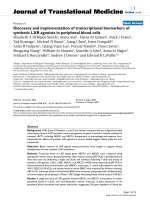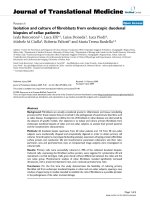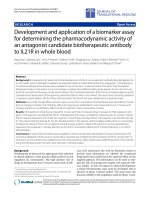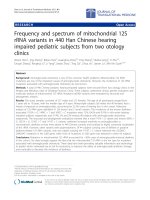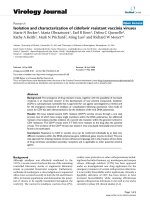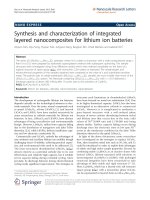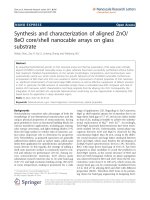Báo cáo hóa học: " Synthesis and characterisation of biologically compatible TiO2 nanoparticles" pot
Bạn đang xem bản rút gọn của tài liệu. Xem và tải ngay bản đầy đủ của tài liệu tại đây (1.12 MB, 6 trang )
NANO EXPRESS Open Access
Synthesis and characterisation of biologically
compatible TiO
2
nanoparticles
Richard W Cheyne
1,2
, Tim AD Smith
2
, Laurent Trembleau
1
and Abbie C Mclaughlin
1*
Abstract
We describe for the first time the synthesis of biocompatible TiO
2
nanoparticles containing a functional NH
2
group
which are easily dispersible in water. The synthesis of water dispersible TiO
2
nanoparticles coated with
mercaptosuccinic acid is also reported. We show that it is possible to exchange the stearic acid from pre-
synthesised fatty acid-coated anatase 5-nm nanoparticles with a range of organic ligands with no change in the
size or morphology. With further organic functionalisation, these nanoparticles could be used for medical imaging
or to carry cytotoxic radionuclides for radioimmunotherapy where ultrasmall nanoparticles will be essential for
rapid renal clearance.
Introduction
Organically functionalised inorganic nanoparticles are
being increasi ngly studied as a result of their many tech-
nological applications. In particular, the synthesis of inor-
ganic nanoparticles for biomedical applications is being
widely researched. Biomedical applications of inorganic
nanoparticles include biosensing [1], targeted drug delivery
agents [2] and contrast agents in magnetic resonance ima-
ging (MRI) [3,4]. Surface-coated superparamagneti c iron
oxide nanoparticles have been extensively employed as
magnetic resonance signal enhancers that can resolve the
weakness of current MRI techniques. Most recently, it has
been shown that by conjugating surface-coated Au-Fe
3
O
4
nanoparticles to both herceptin and cis-platin, the nano-
particles can act as target -specific nanocarriers to deliver
platin into Her2-positive breast can cer cells with strong
therapeutic results [5]. Furthermore, these nanoparticles
can act as both a magnetic and optical probe for tracking
the platin complex in cells and biological systems. How-
ever, the iron oxide nanoparticles commonly used as MRI
contrast agents have a radius of over 50 nm so that they
have a limited extravasation ability and are subject to easy
uptake by the reticuloendothelial system [6,7]. In order to
enhance biological targeting efficiency, ultrasmall nanopar-
ticles with greatly reduced hydrodynamic sizes are desired.
Recently, ultrasmall (core size of 4.5 nm) c(RGDyK)-
coated Fe
3
O
4
nanoparticles have been synthesised [8], and
results show a dramatic increase in cellular uptake. These
nanoparticles were synthesised via thermal decomposition
of Fe(CO)
5
in the presence of the ligand 4-methycatechol
(4-MC). The 4-MC-coated nanoparticles were then conju-
gated with a peptide c(RGDyK) via the Mannich reaction.
There has been much research into the synthesis and
properties of TiO
2
nanoparticles since surface-modified
TiO
2
nanoparticles h ave many applications including
photocatalysis [9] and photoelectric conversion [10,11].
Such research has shown that it is facile to make surface-
coated TiO
2
nanoparticles with an ultrasmall core size of
3 to 5 nm [12,13]. However, the study of TiO
2
nanoparti-
cles for biological applications, which have been shown to
be non-toxic at low doses [14] (5 mg/kg body weight), has
thus far been limited as such TiO
2
nanoparticles are gen-
era lly synthesised v ia a nonhydrolytic method and hence
are non-dispersible in water. There are a couple of exam-
ples of functionalised TiO
2
nanoparticles which are disper-
sible in water [15,16]; however, in these reports, a broad
size distribution is evidenced (3 to 8 nm).
In this paper, we show that it is possible to synthesise
ultrasmall TiO
2
nanoparticles with a core size of 5 nm
with a range of coated short-chain organic functional
groups which are comparable in size to diabodies which
exhibit rapid renal excretion [17]. The organically functio-
nalised nanoparticles are highly dispersible in a range of
solvents, and results show that when coated with aspartic
acid or mercaptosuccinic acid, the nanoparticles are easily
dispersible in water. Hence, for the first time, ultrasmall
biocompatible TiO
2
nanoparticles containing a functional
* Correspondence:
1
The Chemistry Department, University of Aberdeen, AB24 3 UE, UK
Full list of author information is available at the end of the article
Cheyne et al. Nanoscale Research Letters 2011, 6:423
/>© 2011 Cheyne et al; licensee Springer. Thi s is an Open Access article distributed under the terms of the Creative Commons Attribution
License ( icenses/by/2.0), which permits unrestricted use, distribution, and reproduction in any medium,
provided the original work is prope rly cited.
NH
2
or SH group have been synthesised. With further
organic functionalisation and conjugation to a targeting
moiety such as a single-chain antibody fragment or to bio-
tin, these nanoparticles c ould be used to carry multiple
short-lived radionuclides including
99m
Tc and
67
Ga for
medical imaging or to cytotoxic radionuclides for radioim-
munotherapy where ultrasmall nanoparticles will be essen-
tial for rapid renal clearance.
Results and discussion
Nanoparticle preparation
The two-phase thermal synthesis of titanium dioxide
nanoparticles was adapted from a previously described
procedure [13]. Typically, a solution of tert-butylamine
dissolved in water was added to a Teflon-lined steel
autoclave. S eparately, titanium(IV) n-propoxide and
stearic acid (SA) were dissolved in toluene and added to
the autoclave. The autoclave was sealed and heated to
180°C for 16 h and allowed to cool to room tempera-
ture. TiO
2
nanoparticles were recovered by precipitation
with acetonitrile and isolated by fil tration. The “SA-
coated” nanoparticles are dispersible in chloroform and
methanol but are not dispersible in water or acetonitrile.
The approximate number of SA molecules bound to
each nanopartic le core w as calculated to be 500 by fol-
lowing an established procedure [12].
Surface functionalisation
Exchange of the TiO
2
-bound stearic a cid chains with
various carboxylic acids was performed by reacting SA-
coated nanoparticles with excess acids in refluxing
chlo roform. The resulting nanoparticles could be recov-
ered by removal of solvent, re-suspension in acetonitrile,
and filtration. The nanoparticles were dispersed in
appropriate solvents, and nuclear magnetic resonance
(NMR) spectra were taken. The degree of ligand
exchange was determined by integration of the relevant
signals of the distinct functional groups in the proton
NMR spectra. The results are reported in Table 1.
Approximately 37% of the stearic acid cha ins could be
exchanged by benzoic acid (Benz) synthesised under
these conditions. Exchange with phthalic acid led to the
formation of non-dispersible nanoparticles, and the
XRD powder pattern obtained indicates a large propor-
tion of unbound phthalic acid that could not be
removed. Synthesis of aspartic acid (Asp) and glycine
(Gly) nanoparticles without the protective Boc group
were unsuccessful, presumably due to the poor solubility
of l-aspartic acid and glycine in chloroform. Only about
25% of the stearic acid chains could be exchanged by
Boc-glycine (Boc-Gly). But ligand exchange with the
bidentate ligands mercaptosuccinic acid (Mercapto) or
Boc-aspartic acid (Boc-Asp) was almost quantitative as
observed by proton NMR (
1
HNMR).TheBocgroup
was later cleaved with 4 M HCl in dioxane. The result-
ing nanoparticles from both exchanges w ere easily dis-
persed in water (ca. 5 mg/ml), and the dispersion is
stable for days without precipitation.
Characterisation of surface-functionalised nanoparticles
The TEM images of SA- and Asp-coated TiO
2
nanopar-
ticles are presented in Figure 1. The TEM images for
the other coated nanoparticles and higher magnification
images are displayed i n the Additional file (Figures S1
and S2 in Additional file 1). The higher magnificatio n
shows that the nanoparticles prepared are spherical with
a uniform diameter of 5 ± 1 nm, but that the nanoparti-
cles agglomerate. Such agglomeration/aggregation of
TiO
2
nanoparticles is well documented and can be
tuned by altering the pH (for example see references
[9,18,19]). The mean hydrodynamic radius was deter-
mined using dynamic light scattering, and the results
are displayed in Table 2 and confirm that when dis-
persed in solution, the coated TiO
2
nanoparticles form
agglomerates which vary in size from 141 to 601 nm.
Powder X-ray diffraction (XRD) patterns of SA- and
Asp-coated nanoparticles are shown in Figure 2. The
diff raction patterns show that the anatase phase (JCPDS
no. 21-1272) is formed, and the crystallite size was cal-
culated at 5 nm using the Scherrer formula which is in
good agreement with the TEM images [20]. The XRD
patterns of the Benz, Boc-Gly, Boc-Asp, Mercapto and
Gly surface-modified TiO
2
nanoparticles are displayed
in Figures S3 and S4 in Additional file 1. There is no
Table 1 Exchange of the TiO
2
-bound stearic acid chains
with various carboxylic acids
Entry Carboxylic acid (ligand) Ligand exchange (%)
1
37
a,b
2 20
c,d
3 25
a,b
(30)
4
>95
c,b
(>95
e
)
5
>95
f
a
Determined by
1
H NMR (400 MHz, CDCl
3
).
b
XRD powder pattern indicated
essentially pure nanoparticles.
c
The nanoparticles were not dispersible in any
solvent.
d
Based on the recovery yield of ligand in acetonitrile.
e
Determined by
1
H NMR (400 MHz, D
2
O) after removal of the Boc group using HCl/dioxane
(ammonium hydrochloride salt is obtained).
f
Determined by
1
H NMR (400
MHz, D
2
O)
Cheyne et al. Nanoscale Research Letters 2011, 6:423
/>Page 2 of 6
change in particle size or crystal structure upon surface
modification.
The presence of the various surface coatings were con-
firmed by Fourier transform infrared spectroscopy
(FTIR) and
1
H NMR measurements. The spectrum of
pure stearic acid shows the C = O stretch vibration at
1,700 cm
-1
. This band is completel y converted into
three new bands in the spectrum of stearic a cid-coated
TiO
2
nanoparticles as previously reported [12]. Two dif-
ferent carboxylate binding sites can be identified, a brid -
ging co mplex (ν
a
= 1,620 cm
-1
, ν
s
= 1,455 cm
-1
)anda
bidentate complex (ν
a
= 1,521 cm
-1
, ν
s
= 1455 cm
-1
).
The in frared (IR) spectrum of the Benz-coated nanopar-
ticles ( Figure S5 in Additional file 1) shows no evidence
of the fre e acid C = O stretch, and carboxylate peaks
are detected at 1,630, 1,513 and 1,411 cm
-1
, while C = C
aromatic stretch es are detected at 1,599 an d 1,448 cm
-1
.
Upon ligand exchang e with Boc-l-aspartic acid and sub-
sequent removal of the Boc group, a change in the IR
spectrum is evidenced (Figure 3). The carboxylate peaks
shift to 1,506 and 1,410 cm
-1
, and the C-N stretching
vibration is detected at 1,151 cm
-1
.TheN-Hbendis
Figure 1 TEM images of (a) SA-coated and (b) Asp-coated TiO
2
nanoparticles.
Table 2 Mean hydronamic radius for the different
carboxylic acid-coated TiO
2
nanoparticles determined
from DLS measurements
Carboxylic acid (ligand) Mean hydrodynamic radius (nm)
SA 141
Mercapto 192
Asp 202
Gly 508
BA 601
Figure 2 XRD powder patterns of SA and Asp surfa ce-coat ed
TiO
2
nanoparticles. The patterns show formation of 5-nm anatase
phase.
Cheyne et al. Nanoscale Research Letters 2011, 6:423
/>Page 3 of 6
detected by the presence of the strong peak at 1,615 cm
-
1
, demonstrating the presence of a primary amine; how-
ever, a C = O stretch observable at 1,721 cm
-1
suggests
that not all of the carboxylate groups are bound to the
TiO
2
core. Two broad peaks are observed at 3,316 and
3,166 cm
-1
which corresp ond to N-H stretch peaks; the
broadness of the peaks suggests H bonding interactions
between adjacent molecules. The IR spectra of Benz-,
Boc-Gly-, Boc-Asp-, Mercapto- and Gly-coated nanopar-
ticles are displayed in Figure S5 in Additional file 1.
The Asp nanoparticles were further investigated by
NMR. The proton NMR spectrum of free aspartic acid
(Figure 4) shows a doublet of doublets at 4.09 ppm (
3
J =
4.4 Hz;
3
J = 6.8 Hz) and two doublets of doublets at
3.05 ppm (
2
J =18Hz;
3
J = 4.4 Hz) and 2.98 ppm (
2
J =
18 Hz;
3
J = 6.8 Hz). For the aspartic acid-coated nano-
particles, these signals are significantly shifted downfield
(0.05 to 0.17 ppm) and they are slightly broadened. Cur-
iously, the geminal coupling constant for the CH
2
group
has apparently disappeared as the CH group appears as
atriplet(J =5.6Hz)andtheCH
2
groupappearsasa
doublet (J = 5.2 Hz). Since the two methylene hydrogens
are diastereotopic, the most likely explanation to this
anomaly is that the chemical environment of both nuclei
is such that they have almost identical chemical shifts.
The discrepancy in the coupling constants (5.6 versus
5.2 Hz) can be explained by the signals given by the
doublet and triplet appearing slightly broad. A two-
dimensional (2D) correlation spectroscopy (COSY)
experiment on these nanoparticles confirmed this cou-
pling (Figure 5). The strong correlation clearly seen
between the CH triplet (4.25 ppm) and the CH
2
doublet
(3.09 ppm) indicates that despite the unusual coupling
constants obtained from the
1
H NMR, the nuclei in
question are spin coupled. This validates their identities
and indicates that the nanoparticle contains aspartic
acid as a ligand albeit in a slightly altered che mical state
to that of the free acid.
Conclusions
Insummary,wehavecreatedafacileroutetosynthe-
sise ultrasmall surface-coated TiO
2
nanoparticles with
a range o f organic coatings. Furthermor e, the surface-
coated nanoparticles are incredibly robust so that it is
possible to perfor m ligand exchange reactions on the
outer capping groups without disturbing the overall
size or structure morphology of the nanoparticles.
Results suggest that ligand e xchange is most successful
with bidentate ligands as a result of the availability of
two carboxylic acid groups which bind to the TiO
2
core.
This two-step approach toward the synthesis of sur-
face-modified TiO
2
nanoparticles allows for fine tuning
of the nanoparticle core size in the first step before sur-
face modification with suitable ligands in the second. By
separating the surface modification step from that of the
nanoparticle formation, this method allows for the
Figure 3 Solid-state ATR-FTIR spectra of SA-coated (top) and
Asp-coated (bottom) TiO
2
nanoparticles.
Figure 4 Part of the
1
H NMR spectrum (400 MHz) in D
2
O.For
Asp-coated nanoparticles (A) and free aspartic acid-coated
nanoparticles (B). Number sign, residual dioxane from Boc
deprotection.
Figure 5 2D COSY NMR spectrum (400 MHz, D
2
O) of aspartic
acid-coated TiO
2
nanoparticles.
Cheyne et al. Nanoscale Research Letters 2011, 6:423
/>Page 4 of 6
production of identical nanoparticle cores before differ-
entiation by surface modifications. Additionally, the use
of bifunctional ligands to form the nanoparticle coating
allows for the possibility of post-synthesis modifications
to further functionalise the nanoparticle. This may be
beneficial for use in biolog ical applicat ions as the initial
surface functionalisation can convey improved water
solubility before addition of more biologically relevant
moieties. With further organic functionalisation and
conjugation to a targeting moiety, the biolo gical applica-
tions of the nanoparticles d escribed here include the
trans port of multiple short-lived ra dionucl ides including
99
Tc and
67
Ga for medical imaging or to cytotoxic
radionuclides for radioimmunotherapy. The biological
potential of these new nanos tructures is currently being
investigated.
Experimental procedures
General
All ligand exchange reactions were performed under an
argon atmo sphere. All reagents were purchased from
Sigma-Aldrich (Sigma-Aldrich Company Ltd, Dorset,
England) and used without further purification. Cleavage
of Boc protecting gr oups was ach ieved by stir ring in 4 M
HCl/dioxane for 3 h under argon.
Analytical measurements
Routine
1
H NMR and COSY data for TiO
2
nanoparti-
cles were obtained at 400 MHz on a VarianUnity
INOVA instrument (Agilent Technologies Ltd, UKIn -
frared spectra were obtained from 400 scans at 4 cm
-1
resolution using a Nicolet 380 spectrometer (Thermo
Electron Corporation, Franklin, MA, USA) fitted with a
diamond attenuated total reflectance (ATR) platform. IR
and NMR data reported were obtained at room tem-
perature. Room temperature X-ray diffraction patterns
were colle cted for the organically coated TiO
2
nanopar-
ticles on a Bruker D 8 Advance diffractometer (Bruker
AXS Ltd, Coventry, UK) with twin Gobel mirrors using
Cu Ka
1
radiation. Data were collected over the range
20° < 2θ < 80°, with a step size of 0.02°. Transmission
electron microscopy images were obtained for the orga-
nically coated TiO
2
nanoparticles on a Philips
CM10TEM (FEI Ltd, Netherlands). Dynamic light scat-
tering (DLS) was performed using a Malvern mastersizer
(Malvern Instruments Ltd, Malvern, UK).
Synthesis of titanium dioxide nanoparticles
Titanium dioxide nanoparticles were synthesised by a two-
phase thermal approach adapted from a previously
described procedure [13]. Typically, a solution of 0.15 mL
of tert-butylamine (1.43 mmol) dissolved in 14.5 mL of
water was added to a 45-mL Teflon-lin ed steel autoclave.
Separately, 0.225 g of titanium(IV) n-propoxide (0.792
mmol) and 0.75 g of stearic acid (2.64 mmol) were dis-
solved in 14.5 mL of toluene and added to the autoclave
without additional st irring. The autoclave was sealed and
heated to 180°C for 16 h and allowed to cool to room tem-
perature. The TiO
2
nanoparticles were recovered by preci-
pitation with 90 mL of acetonitrile and isolated
by filtration. Off-white solid;
1
HNMR(CDCl
3
); δ 0.88
(t,3H),1.25(s, 30H) and 2.03 (s, 2H); IR ν
max
2,960, 2,915,
2,848, 1,620, 1,521, 1,455, 1,400, 1,300, 1,258, 1,220 and 1,
066 cm
-1
.
Procedure for surface modification of nanoparticles
A solution of carboxylic acid (150 mg) in 5 mL chloroform
was added to a reaction vesse l containing a dispersion of
“ SA-coa ted” TiO
2
nanoparticles (100 mg) in 10 mL
chloroform. The reaction was stirred for 18 h under reflux.
The resultant surface-modified nanoparticles were recov-
ered by evaporation of the solvent in vacuo, re-suspension
in acetonitrile and filtration. Unbound starting material
was removed by repeated washings of the nanoparticles
with acetonitrile.
Benzoic acid exchanged TiO
2
Off-white solid; 86% yield;
1
H NMR indicates an incom-
plete exchange (37%) of stearic acid with benzoic acid;
1
H
NMR (CDCl
3
); δ 0.88 (t,3H),1.28(s, 2 8H), 1.65 (t,2H),
2.34 (t,2H),7.42(t,1.2H),7.53(t, 0.6H) and 8.06 (d,
1.2H); IR ν
max
2,956, 2,919, 2, 849, 1,630, 1,599 , 1, 513,
1,448 and 1,411 cm
-1
.
Glycine exchanged TiO
2
Synthesis was performed f rom Boc-glycine. Cleavage of
the protecting group was achieved by stirring the resulting
nanoparticles under argon in 4 M HCl/dioxane for 3 h.
Off-white solid; 91% yield;
1
H NMR indicates an incom-
plete exchange (30%) of stearic acid with glycine;
1
HNMR
(CDCl
3
); δ 0.88 (t, 3H), 1.25 (s, 30H), 2.02 (d, 2H), 2.33 (s,
1H), 3.75 ( s,1.4H);IRν
max
3,319, 3,115, 2,9 91, 2,928,
1,742, 1,613, 1,495, 1,435, 1,406, 1,337, 1,305, 1,248, 1,118,
1,066and901cm
-1
.
Aspartic acid exchanged TiO
2
Synthesis was performed from Boc-aspartic acid. Clea-
vage of the protecting group was achieved by stirring the
resulting nanoparticles under argon in 4 M HCl/dioxane
for 3 h. Off-white solid; >95% yield;
1
HNMR(D
2
O); δ
1.40 (s,0.4H),2.03(s,0.4H),2.13(s, 0.3H), 3.09 (d,2H,
J = 5.2 Hz), 4.25 (t,1H,J = 5.6 Hz); COSY clearly shows
coupling between the protons of the doublet (δ 3.09) and
triplet (δ 4.25); IR ν
max
3,316, 3,166, 2,970, 2,910, 1,721,
1,615, 1,506, 1,410, 1,346, 1,296, 1,253, 1,220, 1,151 and
1,066 cm
-1
.
Cheyne et al. Nanoscale Research Letters 2011, 6:423
/>Page 5 of 6
Phthalic acid exchanged TiO
2
Off-white solid; purification not possible; resulting nano-
particles not dispersible.
Mercaptosuccinic acid exchanged TiO
2
Synthesis was performed using mercaptosuccinic acid. To
reduce the possibility of oxidation occurring between mer-
captosuccinic acid moieties, the reaction was performed
under anhydrous conditions but in an otherwise identical
manner to previous exchange reactions. Pale-yellow solid;
>95% yield;
1
HNMR(D
2
O); δ 2.62 (m,1H)and2.91
(m,1H);IRν
max
2,915, 2,848, 1,6 85, 1,535, 1,515, 1,442
and 1,384 cm
-1
.
Additional material
Additional file 1: Supplementary data. X-ray diffraction, TEM and
spectroscopic data for coated titanium nanoparticles.
Acknowledgements
We thank Mr Kevin Mackenzie for making TEM measurements. This work
was supported by the Breast Cancer Campaign.
Author details
1
The Chemistry Department, University of Aberdeen, AB24 3 UE, UK
2
School
of Medical Sciences, University of Aberdeen, AB25 2ZD, UK
Authors’ contributions
ACM, LT and TADS designed the study; RC performed the experiments with
help from ACM, LT and TADS; All authors contributed to drafting the
manuscript; All authors edited and approved the manuscript.
Competing interests
The authors declare that they have no competing interests.
Received: 31 August 2010 Accepted: 14 June 2011
Published: 14 June 2011
References
1. Miller MM, Prinz GA, Cheng SF, Bounnak S: Detection of a micron-sized
magnetic sphere using a ring-shaped anisotropic magnetoresistance-
based sensor: A model for a magnetoresistance-based biosensor. Appl
Phys Lett 2002, 81:2211.
2. Jain TK, Morales MA, Sahoo SK, Leslie-Pelecky DL, Labhasetwar V: Iron oxide
nanoparticles for sustained delivery of anticancer agents. Mol Pharm
2005, 2:194.
3. Modo M, Bulté JW: Cellular MR imaging. Mol Imaging 2005, 4:143.
4. Modo MMJ, Bulté JWM: Molecular and Celullar MR Imaging Boca Raton: CRC;
2007.
5. Xu CJ, Wang BD, Sun SH: Dumbbell-like Au-Fe
3
O
4
Nanoparticles for
Target-Specific Platin Delivery. J Am Chem Soc 2009, 131:4216.
6. Moghimi SM, Hunter AC, Murray JC: Long-circulating and target-specific
nanoparticles: Theory to practice. Pharm Rev 2001, 53:283.
7. Neuberger T, Schopf B, Hofmann H, Hofmann M, von Rechnenberg BJ:
Superparamagnetic nanoparticles for biomedical applications:
Possibilities and limitations of a new drug delivery system. J Magn Mag
Mater 2005, 293:483.
8. Xie J, Lee HY, Xu CJ, Hsu AR, Peng S, Chen XY, Sun SH: Ultrasmall c
(RGDyK)-coated Fe
3
O
4
nanoparticles and their specific targeting to
integrin alpha(v)beta(3)-rich tumor cells. J Am Chem Soc 2008, 130:7542.
9. Wang BQ, Jing LQ, Qu YC, Li SD, Jiang BJ, Yang LB, Xin BF, Fu HG:
Enhancement of the photocatalytic activity of TiO
2
nanoparticles by
surface-capping DBS groups. Applied Surface Science 2006, 252:2817.
10. Cahen D, Hodes G, Gratzel M, Guillemoles JF, Riess I: Nature of
photovoltaic action in dye-sensitized solar cells. J Phys Chem B 2000,
104:2053.
11. Jensen H, Fermin DJ, Moser JE, Girault HH: Organization and reactivity of
nanoparticles at molecular interfaces. Part 1. Photoelectrochemical
responses involving TiO
2
nanoparticles assembled at polarizable water
vertical bar 1,2-dichloroethane junctions. J Phys Chem B 2002, 106:10908.
12. Beek WJE, Janssen RA: Photoinduced electron transfer in
heterosupramolecular assemblies of TiO
2
nanoparticles and
terthiophene carboxylic acid in apolar solvents. J Adv Funct Mater 2002,
12:519.
13. Pan DC, Zhao NN, Wang Q, Jiang SC, Ji XL, An LJ: Facile synthesis and
characterization of luminescent TiO
2
nanocrystals. Adv Mater 2005,
17:1991.
14. Fabian E, Landsiedel R, Ma-Hock L, Wiench K, Wohlleben W, van
Ravenzwaay B: Tissue distribution and toxicity of intravenously
administered titanium dioxide nanoparticles in rats. Arch Toxicol 2008,
82:151.
15. Niederberger M, Garnweitner G, Krumeich F, Nesper R, Cölfen H,
Antonietti M: Tailoring the surface and solubility properties of
nanocrystalline titania by a nonaqueous in situ functionalization process.
Chem Mater 2004, 16:1202.
16. Kotsokechagia T, Cellesi F, Thomas A, Niederberger M, Tirelli N: Preparation
of ligand-free TiO
2
(anatase) nanoparticles through a nonaqueous
process and their surface functionalization. Langmuir 2008, 24:6988.
17. Cai WB, Olafsen T, Zhang XZ, Cao QZ, Gambhir SS, Williams LE, Wu AM,
Chen XB: PET imaging of colorectal cancer in xenograft-bearing mice by
use of an F-18-labeled T84.66 anti-carcinoembryonic antigen diabody. J
Nucl Med 2007, 48:304.
18. Reyes-Coronado D, Rodriguez-Gattorno D, Espinosa-Pesqueira ME, Cabb C,
De Cross R, Oskam G: Phase-pure TiO
2
nanoparticles: anatase, brookite
and rutile. Nanotechnology 2008, 19:145605.
19. Jiang JK, Oberdorster G, Biswas P: Characterization of size, surface charge,
and agglomeration state of nanoparticle dispersions for toxicological
studies. J Nanoparticle Res 2009, 11:77.
20. Nanda J, Sapra S, Sarma DD, Chandrasekharan N, Hodes G: Size-selected
zinc sulfide nanocrystallites: Synthesis, structure, and optical studies.
Chem Mater 2000, 12:1018.
doi:10.1186/1556-276X-6-423
Cite this article as: Cheyne et al.: Synthesis and characterisation of
biologically compatible TiO
2
nanoparticles. Nanoscale Research Letters
2011 6:423.
Submit your manuscript to a
journal and benefi t from:
7 Convenient online submission
7 Rigorous peer review
7 Immediate publication on acceptance
7 Open access: articles freely available online
7 High visibility within the fi eld
7 Retaining the copyright to your article
Submit your next manuscript at 7 springeropen.com
Cheyne et al. Nanoscale Research Letters 2011, 6:423
/>Page 6 of 6
